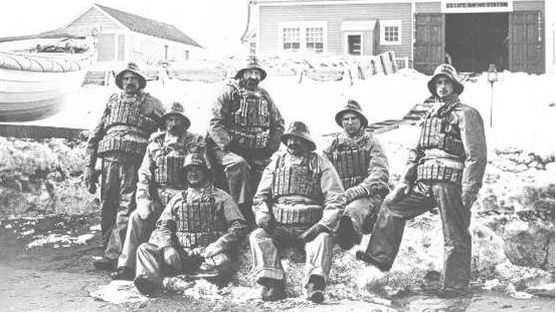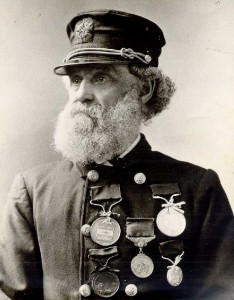225 Years of Service: Search and Rescue

By William Thiesen, Atlantic Area historian
Those familiar with Coast Guard history know that the Service’s development has been shaped in part by the nation’s response to natural and man-made disasters. Nowhere is that lesson clearer than the history of the Service’s search and rescue, or SAR, mission.
The Revenue Cutter Service, one of the predecessor services to the Coast Guard, assisted mariners at sea beginning in the 1790s. However, this core mission did not receive official sanction until 1837. That year, the bark Mexico came ashore near New York Harbor with the loss of over 100 passengers and crew.
In response to this tragedy, federal officials recognized the need for government assistance for ships in danger. In December of that year, Congress passed legislation assigning revenue cutters responsibility for aiding vessels requiring assistance. Ironically, that same year saw the construction of the three-masted ship Powhatan, another vessel that played a role in spurring federal lifesaving legislation.
In 1854, two major maritime disasters took place in New Jersey. In April, more than two hundred lives were lost when the Powhatan wrecked on the Jersey Shore. In November, another 220 lives were lost when the ship New Era came ashore in New Jersey.
In response to this horrific loss of life, Congress passed what became known as the Act of December 15, 1854. This proved one of the most sweeping bills in U.S. lifesaving history, greatly expanding the federal government’s ability to support lifesaving efforts.
The late summer and early winter of 1870 proved another deadly shipwreck season. The numerous ships wrecking on U.S. shores raised awareness of the nation’s inadequate land-based lifesaving capability.
Secretary of the Treasury George Boutwell responded by establishing a superintendent’s position to direct the Department’s Revenue Marine Division, which oversaw steamboat inspection, marine hospitals and lifesaving stations. In February 1871, Boutwell appointed Superintendent Sumner Kimball, who initiated the rapid expansion of U.S. lifesaving operations and, in 1878, established the U.S. Life-Saving Service.

The late 1800s and early 1900s, saw hundreds of surfmen from the U.S. Life-Saving Service go in harm’s way to save the victims of maritime disasters. These heroic individuals included Captain Joshua James, who served as a lifesaver for sixty years.
During his career, he earned almost every medal available to surfmen for maritime rescues. James’s medals included the prestigious Gold Lifesaving Medal, which he received in 1888 for rescuing survivors from five different shipwrecks during a severe two-day winter storm. Kimball believed James to be the most important lifesaver in the history of the Service.
During James’ lengthy career, the Life-Saving Service saw the development of improved lifesaving technology, including new rescue devices, improved flares and personal floatation devices, tractor-pulled beach equipment and motorized lifeboats. During this same period, the Revenue Cutter Service saw the technological transition of its cutters from ponderous wooden sailing vessels to fast steel-hulled propeller steamships.
In 1915, Congress passed important lifesaving legislation once again. This time, the bill merged the U.S. Revenue Cutter Service and U.S. Life-Saving Service. In so doing, this act combined the federal government’s two agencies responsible for maritime safety on land and at sea into one modern organization with overall jurisdiction: the U.S. Coast Guard.
Not long after formation of the modern-day Coast Guard, rapid advances took place in seaborne aviation technology. The Service soon added an amphibian fixed-wing aircraft capability to the fleet of lifesaving boats and Coast Guard cutters already supporting the SAR mission. These new Coast Guard aircraft provided rapid response assets for over-the horizon rescues and they served in numerous high-profile cases, including Gold Lifesaving Medal rescues in 1929, 1933 and 1937.
During the 1930s, the Service continued to perfect the use of amphibian aircraft for SAR cases. However, in World War II, the Coast Guard developed the helicopter, a new form of aviation technology that has since become synonymous with the Service’s SAR mission.
Coast Guard helicopters and their associated rescue hoist devices improved in the decades following the war and rotary-wing assets gradually supplanted fixed-wing amphibian aircraft as the Service’s primary aviation asset. In 1983, the tragic loss of the SS Marine Electric and most of her crew, spurred Congress to pass legislation establishing the Coast Guard’s rescue swimmer program. This bill added yet another valuable piece to the Service’s modern search and rescue system.
In 2006, the Coast Guard’s SAR mission saw a different call for help when Hurricane Katrina ravished the Gulf Coast. During the weeks that followed, the Coast Guard responded to the nearly 60,000 people awaiting rescue from rooftops and flooded homes. Of those 60,000, Coast Guard men and women rescued more than 33,500 people.
While marine accidents and changing technology has shaped the Coast Guard’s SAR mission from the early 1800s to present day, it remains clear that the Coast Guard stands ready to adapt to the changing environment and needs of the Nation to provide these crucial rescue services.
2015 marks the 225th birthday of the United States Coast Guard.
The opinions expressed herein are the author's and not necessarily those of The Maritime Executive.
